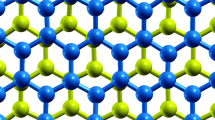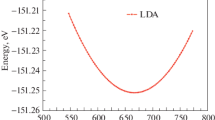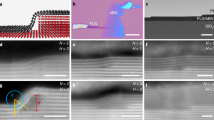Abstract
This paper discusses a set of recent experimental results in which the mechanical properties of monolayer graphene molecules were determined. The results included the second-order elastic modulus which determines the linear elastic behavior and an estimate of the third-order elastic modulus which determines the non-linear elastic behavior. In addition, the distribution of the breaking force strongly suggested the graphene to be free of defects, so the measured breaking strength of the films represented the intrinsic breaking strength of the underlying carbon covalent bonds. The results of recent simulation efforts to predict the mechanical properties of graphene are discussed in light of the experiments. Finally, this paper contains a discussion of some of the extra challenges associated with experimental validation of multi-scale models.
Similar content being viewed by others
References
Lee C., Wei X.D., Kysar J.W., Hone J. (2008) Measurement of the elastic properties and intrinsic strength of monolayer graphene. Science 321(5887): 385–388
Pablo J.J., Curtin W.A.: Multiscale modeling in advanced materials research: challenges, novel methods, and emerging applications. MRS Bull. 32, 905–909 (2007)
Becker R.: Developments and trends in continuum plasticity. J. Comput-Aided Mater. Des. 9(2), 145–163 (2002)
Chandler E., Moriarty J., de la Rubia T.D., Couch R.: LLNL’s dynamics of metals program: multi-scale modeling of plasticity and dynamic failure. Abstr. Pap. Am. Chem. Soc 222, U13–U13 (2001)
Buehler M.J., Hartmaier A., Gao H.: Hierarchical multi-scale modelling of plasticity of submicron thin metal films. Model. Simul. Mater. Sci. Eng. 12(4), S391–S413 (2004)
Clayton J.D., McDowell D.L.: Homogenized finite elastoplasticity and damage: theory and computations. Mech. Mater. 36(9), 799–824 (2004)
Hao S., Liu W.K., Moran B., Vernerey F., Olson G.B.: Multi-scale constitutive model and computational framework for the design of ultra-high strength, high toughness steels. Comput. Methods Appl. Mech. Eng. 193(17–20), 1865–1908 (2004)
Khan S.M.A., Zbib H.M., Hughes D.A.: Modeling planar dislocation boundaries using multi-scale dislocation dynamics plasticity. Int. J. Plast. 20(6), 1059–1092 (2004)
Belak J.: Multi-scale applications to high strain-rate dynamic fracture. J. Comput. Aided Mater. Des. 9(2), 165–172 (2002)
Curtin W.A., Miller R.E.: coupling in computational materials science. Model. Simul. Mater. Sci. Eng. 11(3), R33–R68 (2003)
Zbib H.M., de la Rubia T.D. : A multiscale model of plasticity. Int. J. Plast. 18(9), 1133–1163 (2002)
Hartley C.S.: Multi-scale modeling of dislocation processes. Mater. Sci. Eng. A Struct. Mater. Prop. Microstruct. Process. 319, 133–138 (2001)
Stainier L., Cuitino A.M., Ortiz M.: A micromechanical model of hardening, rate sensitivity and thermal softening in bcc single crystals. J. Mech. Phys. Solids 50(7), 1511–1545 (2002)
Stainier L., Cuitino A.M., Ortiz M.: Multiscale modelling of hardening in BCC crystal plasticity. J. Phys. Iv 105, 157–164 (2003)
Cuitino A.M., Stainier L., Wang G.F., Strachan A., Cagin T., Goddard W.A., Ortiz M.: A multiscale approach for modeling crystalline solids. J. Comput. Aided Mater. Des. 8(2–3), 127–149 (2002)
Cuitino A.M., Ortiz M.: Computational modeling of single-crystals. Model. Simul. Mater. Sci. Eng. 1(3), 225–263 (1993)
Horstemeyer M.F., Baskes M.I., Prantil V.C., Philliber J., Vonderheide S.: A multiscale analysis of fixed-end simple shear using molecular dynamics, crystal plasticity, and a macroscopic internal state variable theory. Model. Simul. Mater. Sci. Eng. 11(3), 265–286 (2003)
Baskes M.I.: The status role of modeling and simulation in materials science and engineering. Curr. Opin. Solid State Mater. Sci. 4(3), 273–277 (1999)
Horstemeyer M.F., Baskes M.I.: Atomistic finite deformation simulations: a discussion on length scale effects in relation to mechanical stresses. J. Eng. Mater. Technol. Trans. ASME 121(2), 114–119 (1999)
Campbell G.H., Foiles S.M., Huang H.C., Hughes D.A., King W.E., Lassila D.H., Nikkel D.J., de la Rubia T.D. , Shu J.Y., Smyshlyaev V.P.: Multi-scale modeling of polycrystal plasticity: a workshop report. Mater. Sci. Eng. A Struct. Mater. Prop. Microstruct. Process. 251(1–2), 1–22 (1998)
Hansen N., Hughes D.A.: Analysis of large dislocation populations in deformed metals. Phys. Status Solidi A Appl. Res. 149(1), 155–172 (1995)
Horstemeyer M.F., Baskes M.I., Godfrey V., Hughes D.A.: A large deformation atomistic study examining crystal orientation effects on the stress–strain relationship. Int. J. Plast. 18(2), 203–229 (2002)
Godfrey A., Hughes D.A.: Physical parameters linking deformation microstructures over a wide range of length scale. Scr. Mater. 51(8), 831–836 (2004)
de la Rubia T.D. , Bulatov V.V.: Materials research by means of multiscale computer simulation. Mater. Res. Soc. Bull. 26(3), 169–175 (2001)
Soderlind P., Moriarty J.A.: First-principles theory of Ta up to 10 Mbar pressure: structural and mechanical properties. Phys. Rev. B 57(17), 10340–10350 (1998)
Ogata S., Li J., Hirosaki N., Shibutani Y., Yip S.: Ideal shear strain of metals and ceramics. Phys. Rev. B. 70(10), 104104 (2004)
Ogata S., Li J., Yip S.: Ideal pure shear strength of aluminum and copper. Science 298(5594), 807–811 (2002)
Shibutani Y., Krasko G.L., Sob M., Yip S.: Atomic-level description of material strength of alpha-Fe. Mater. Sci. Res. Int. 5(4), 225–233 (1999)
Widom M., Moriarty J.A.: First-principles interatomic potentials for transition-metal aluminides. II. Application to Al-Co and Al-Ni phase diagrams. 58(14), 8967–8979 (1998)
Moriarty J.A., Belak J.F., Rudd R.E., Soderlind P., Streitz F.H., Yang L.H.: Quantum-based atomistic simulation of materials properties in transition metals. J. Phys. Condens. Matter 14(11), 2825–2857 (2002)
Moriarty J.A., Vitek V., Bulatov V.V., Yip S.: Atomistic simulations of dislocations and defects. J. Comput. Aided Mater. Des. 9(2), 99–132 (2002)
Yang L.H., Soderlind P., Moriarty J.A.: Atomistic simulation of pressure-dependent screw dislocation properties in bcc tantalum. Mater. Sci. Eng. A Struct. Mater. Prop. Microstruct. Process. 309, 102–107 (2001)
Schiotz J., Jacobsen K.W.: A maximum in the strength of nanocrystalline copper. Science 301(5638), 1357–1359 (2003)
Bulatov V.V.: Current developments and trends in dislocation dynamics. J. Comput. Aided Mater. Des. 9(2), 133–144 (2002)
Hiratani M., Bulatov V.V.: Solid-solution hardening by point-like obstacles of different kinds. Philos. Mag. Lett. 84(7), 461–470 (2004)
Cai W., Bulatov V.V.: Mobility laws in dislocation dynamics simulations. Mater. Sci. Eng. A Struct. Mater. Prop. Microstruct. Process. 387–389, 277–281 (2004)
Liu F., Ming P., Li J.: Ab initio calculation of ideal strength and phonon instability of graphene under tension. Phys. Rev. B 76, 064120 (2007)
Arsenlis A., Wirth B.D., Rhee M.: Dislocation density-based constitutive model for the mechanical behaviour of irradiated Cu. Philos. Mag. 84(34), 3617–3635 (2004)
Arsenlis A., Parks D.M., Becker R., Bulatov V.V.: On the evolution of crystallographic dislocation density in non-homogeneously deforming crystals. J. Mech. Phys. Solids 52(6), 1213–1246 (2004)
Arsenlis A., Tang M.J.: Simulations on the growth of dislocation density during Stage 0 deformation in BCC metals. Model. Simul. Mater. Sci. Eng. 11(2), 251–264 (2003)
Arsenlis A., Parks D.M.: Modeling the evolution of crystallographic dislocation density in crystal plasticity. J. Mech. Phys. Solids 50(9), 1979–2009 (2002)
Kysar J.W.: Energy dissipation mechanisms in ductile fracture. J. Mech. Phys. Solids 51(5), 795–824 (2003)
Larson B.C., El-Azab A., Yang W.G., Tischler J.Z., Liu W.J., Ice G.E.: Experimental characterization of the mesoscale dislocation density tensor. Philos. Mag. 87(8–9), 1327–1347 (2007)
Uchic M.D., Dimiduk D.M., Florando J.N., Nix W.D.: Sample dimensions influence strength and crystal plasticity. Science 305(5686), 986–989 (2004)
Nicks L.J., Nehl F.H., Chambers M.F.: Recovering flake graphite from steelmaking kish. J. Mater. 47(6), 48–51 (1995)
Novoselov K.S., Jiang D., Schedin F., Booth T.J., Khotkevich V.V., Morozov S.V., Geim A.K.: Two-dimensional atomic crystals. Proc. Natl. Acad. Sci. USA 102(30), 10451–10453 (2005)
Komaragiri U., Begley M.R.: The mechanical response of freestanding circular elastic films under point and pressure loads. J. Appl. Mech. Trans. ASME 72(2), 203–212 (2005)
Schwerin E.: Über Spannungen und Formänderungen kreisringförmiger Membranen. Z. Tech. Phys. 10(12), 651–659 (1929)
Barber A.H., Andrews R., Schadler L.S., Wagner H.D.: On the tensile strength distribution of multiwalled carbon nanotubes. Appl. Phys. Lett. 87, 203106 (2005)
Stolyarova E., Rim K.T., Ryu S.M., Maultzsch J., Kim P., Brus L.E., Heinz T.F., Hybertsen M.S., Flynn G.W.: High-resolution scanning tunneling microscopy imaging of mesoscopic graphene sheets on an insulating surface. Proc. Natl. Acad. Sci. USA 104(22), 9209–9212 (2007)
Coulson C.A., Santos E, Senent S., Leal M., Herraez M.A.: Formation energy of vacancies in graphite crystals. Proc. R. Soc. Lond. A Math. Phys. Sci. 274, 461–479 (1963)
El-Barbary, A.A., Telling, R.H., Ewels, C.P., Heggie, M.I. and Briddon,P.R.: Structure and energetics of the vacancy in graphite. Phys. Rev. B. 68(14) (2003). Article Number 144107
Grenall A.: Direct observation of dislocations in graphite. Nature 182(4633), 448–450 (1958)
Williamson G.K.: Electron microscope studies of dislocation structures in graphite. Proc. R. Soc. Lond. A Math. Phys. Sci. 257(1291), 457–& (1960)
Yakobson B.I., Brabec C.J., Bernholc J.: Nanomechanics of carbon tubes: instabilities beyond linear response. Phys. Rev. Lett. 76(14), 2511–2514 (1996)
Bhatia N.M., Nachbar W.: Finite indentation of an elastic membrane by a spherical indenter. Int. J. Nonlinear Mech. 3(3), 307–324 (1968)
Brugger K.: Thermodynamic definition of highter order elastic coefficients. Phys. Rev. A Gen. Phys. 133(6A), A1611–A1612 (1964)
Brugger K.: Pure modes for elastic waves in crystals. Journal of Applied Physics 36(3), 759–768 (1965)
Brugger K.: Determination of 3rd-order elastic coefficients in crystals. J. Appl. Phys. 36(3), 768–773 (1965)
Lubarda V.A.: Apparent elastic constants of cubic crystals and their pressure derivatives. Int. J. Non-Linear Mech. 34(1), 5–11 (1999)
Huang Y., Wu J., Hwang K.C.: Thickness of graphene and single-wall carbon nanotubes. Phys. Rev. B 74, 245413 (2006)
Pantano A., Parks D.M., Boyce M.C.: Mechanics of deformation of single- and multi-wall carbon nanotubes. J. Mech. Phys. Solids 52, 789–821 (2004)
Carter E.A.: Challenges in modeling materials properties without experimental input. Science 321(5890), 800–803 (2008)
Khare R., Mielke S.L., Paci J.T., Zhang S., Ballarini R., Schatz G., Belytschko T.: Coupled quantum mechanical/molecular mechanical modeling of the fracture of defective carbon nanotubes and graphene sheets. Phys. Rev. B 75, 075412 (2007)
Stone A.J.: Intermolecular potentials. Science 321, 787–789 (2008)
Porter L.J., Li J., Yip S.: Atomistic modeling of finite-temperature properties of b-SiC. I. Lattice vibration, heat capacity and thermal expansion. J. Nucl. Mater. 246, 53–59 (1997)
Author information
Authors and Affiliations
Corresponding author
Rights and permissions
About this article
Cite this article
Kysar, J.W. Direct comparison between experiments and computations at the atomic length scale: a case study of graphene. Sci Model Simul 15, 143–157 (2008). https://doi.org/10.1007/s10820-008-9105-1
Received:
Accepted:
Published:
Issue Date:
DOI: https://doi.org/10.1007/s10820-008-9105-1




